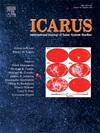用兹威基瞬变设备光度曲线估计木星特洛伊的旋转周期
IF 3
2区 物理与天体物理
Q2 ASTRONOMY & ASTROPHYSICS
引用次数: 0
摘要
我们利用兹威基瞬变设施(ZTF)的光度数据对216颗木星特洛伊行星进行了新的旋转周期估计,其中包括80颗以前未知周期的特洛伊行星。我们的分析显示,旋转周期从4.6小时到447.8小时不等。这些结果支持大于10公里的特洛伊木马存在一个自旋屏障,周期聚集在4到4.8小时之间。这个自旋屏障大约是观测到的主带小行星的两倍长,这表明木星特洛伊木马的体积密度明显较低,可能是由于其成分中冰和挥发性物质的比例较高。我们在自旋势垒附近确定了三个具有可靠旋转周期的新木马,使已知木马的数量增加了一倍。利用这些结果,我们估计瓦砾堆木马的平均密度为~ 0.52g/cm3。我们的发现为越来越多的证据做出了贡献,这些证据表明,与主带小行星相比,许多特洛伊木马是具有独特物理特性的瓦砾堆体。展望未来,我们预计Vera C. Rubin天文台的遗留空间和时间调查(LSST)即将提供的数据将提供几十万个特洛伊木马的旋转周期估计,小到1公里的物体,能够更详细地研究它们的旋转特性和内部结构。本文章由计算机程序翻译,如有差异,请以英文原文为准。
Estimates of rotation periods for Jupiter Trojans with the Zwicky Transient Facility photometric lightcurves
We present new rotational period estimates for 216 Jupiter Trojans using photometric data from the Zwicky Transient Facility (ZTF), including 80 Trojans with previously unknown periods. Our analysis reveals rotation periods ranging from 4.6 h to 447.8 h. These results support the existence of a spin barrier for Trojans larger than 10 km, with periods clustering between 4 and 4.8 h. This spin barrier is roughly twice as long as that observed for main-belt asteroids, suggesting that Jupiter Trojans have significantly lower bulk densities, likely due to a higher fraction of ices and volatile materials in their composition. We identify three new Trojans with reliable rotation periods near the spin barrier, doubling the number of known Trojans in this critical period range. Using these results, we estimate a mean density of for rubble-pile Trojans. Our findings contribute to the growing body of evidence that many Trojans are rubble-pile bodies with distinct physical properties compared to main-belt asteroids. Looking forward, we anticipate that forthcoming data from the Vera C. Rubin Observatory’s Legacy Survey of Space and Time (LSST) will provide rotational period estimates for several hundred thousand Trojans, down to objects as small as 1 km, enabling a more detailed investigation of their rotational properties and internal structure.
求助全文
通过发布文献求助,成功后即可免费获取论文全文。
去求助
来源期刊

Icarus
地学天文-天文与天体物理
CiteScore
6.30
自引率
18.80%
发文量
356
审稿时长
2-4 weeks
期刊介绍:
Icarus is devoted to the publication of original contributions in the field of Solar System studies. Manuscripts reporting the results of new research - observational, experimental, or theoretical - concerning the astronomy, geology, meteorology, physics, chemistry, biology, and other scientific aspects of our Solar System or extrasolar systems are welcome. The journal generally does not publish papers devoted exclusively to the Sun, the Earth, celestial mechanics, meteoritics, or astrophysics. Icarus does not publish papers that provide "improved" versions of Bode''s law, or other numerical relations, without a sound physical basis. Icarus does not publish meeting announcements or general notices. Reviews, historical papers, and manuscripts describing spacecraft instrumentation may be considered, but only with prior approval of the editor. An entire issue of the journal is occasionally devoted to a single subject, usually arising from a conference on the same topic. The language of publication is English. American or British usage is accepted, but not a mixture of these.
 求助内容:
求助内容: 应助结果提醒方式:
应助结果提醒方式:


